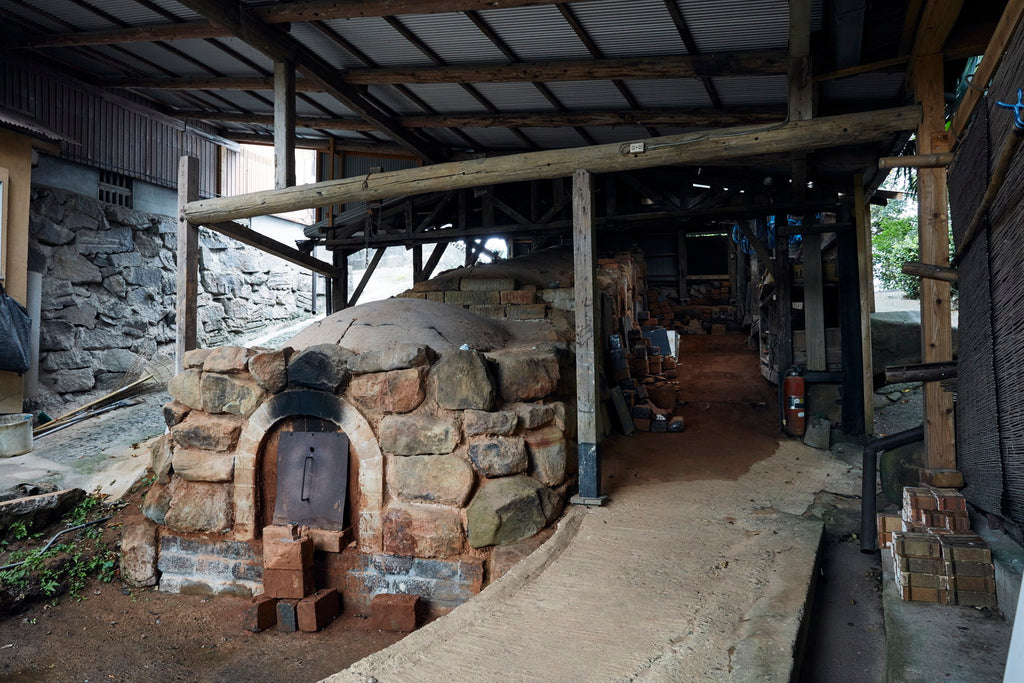Firing process of the sectioned bamboo style kiln(Naoto Yano)

There are different types of kilns for firing ceramic. Electric kiln is the most common where heat generated by electric power. Besides, gas kiln, kerosene kiln and wood-fired kiln is used, depending on the characteristic of the art piece which ceramic artists prefer. Today, we will see the firing process in the kiln which Karatsu artist, Naoto Yano uses.
This is the climbing kiln Mr. Yano uses. He used to use the one called the renbo-shiki (connected cluster style) which looks like connected semi-cylindrical shapes, but changed to the waritake-shiki (sectioned bamboo) with the flat ceiling after six months of renovation work last year. While the renbo-shiki has round ceilings for the better heat efficiency, the waritake-shiki divides the chamber of the straight ceiling into sub-chambers so that the fire flows irregularly, enabling to produce interesting ceramics.
Firing. It is 16:00 now. The firing started at 20:00 yesterday, and about 20 hours has passed. A single firing takes around 30 hours.
The climbing kiln is composed of five sub-chambers from the “Doginoma”, the most front sub-chamber, and following by the “Ichinoma” to the “Yonnoma”. This thermometer is placed in the “Ichinoma”, and the temperature in the “Doginoma” already exceeds 1,200 Centigrade at this moment.
A quick glance at the inside of the kiln. Large vases are usually placed in the “Doginoma” to prevent the fire entering the “Ichinoma” directly. As he doesn’t have large vases this time, he places the firing crocks to control the fire flow.
The evening deepend into the night.
The kiln is filled with the blazing fire. How magnificent the flicker is!
When the firing at the “Doginoma” is completed, the horizontal firings at the “Ichinoma” to the “Yonnoma” start. These four sub-chambers are already quite hot from the heat of the “Doginoma” firing, thus the firing at each sub-chamber lasts only 1 to 3 hours.
As the horizontal firing starts, the fire in the kiln becomes fiercer. Flame comes out from the kiln ceiling.
When the firing at the “Ichinoma” is completed, the fire hole is closed. Air moves from the cold place to the warm ones, this process avoid cold air that comes from outside suddenly chilling the kiln, or bringing the dust.
The next step is the firing at the “Ninoma”. The firing by each sub-chamber, from the bottom to the top, is typical for climbing kiln firing.
A quick glance at the inside of the “Ninoma”. A Madara Garatsu tea bowl is placed in the front. This is an experiment how it turns out as he intentionally places the piece at the position where plenty of ash falls.
The firing is approaching to the final stage. The back chimney of the climbing kiln shoots fire furiously.
It is nearly 2 am, firing at the “Yonnoma” starts now.
It is past 3am, and this round of firing is completed. The kiln and the contents will be let stand for the next 3 days as they cools down slowly before the ceramic pieces are unloaded. Mr. Yano fires 4 times per year using this climbling kiln. Please visit his exhibitions and our web gallery to see his outstanding works.
Date of Interview/Photo: November 4 & 5, 2016 (firing)
Photographer: Fumihiko Sekiguchi
Unauthorized use or reproduction of these photos is prohibited.
